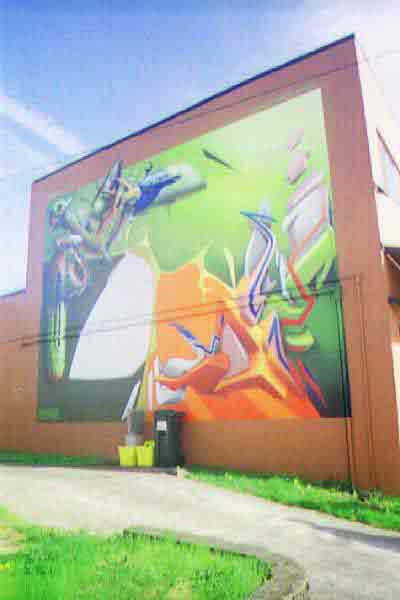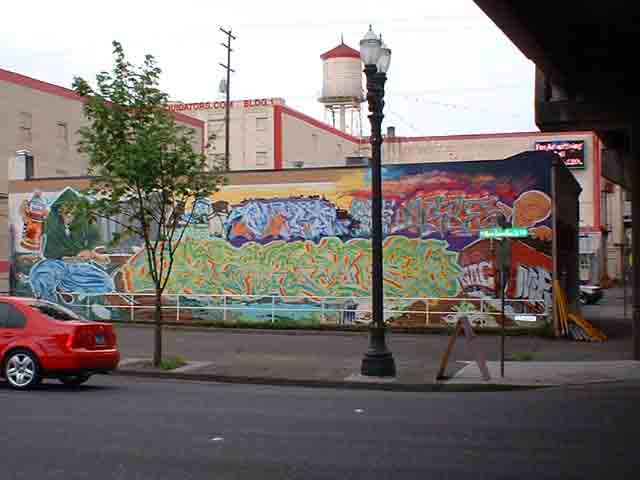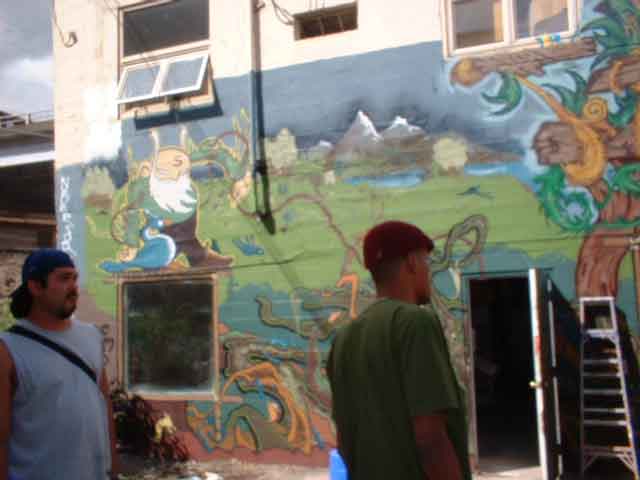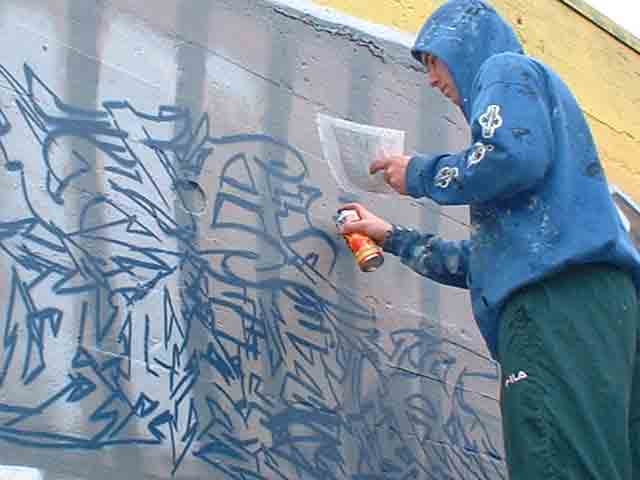
 |
The city’s fight with Clear Channel over what constitutes
commercial speech has choked a strong mural tradition in the city. There’s
little sign things will improve any time soon.
By Joanne Oleksiak
“The highest, most logical, purest, and most powerful type of painting is mural painting. . .it cannot be converted into a object of personal gain nor can it be concealed for the benefit of a few privileged people. It is for the people. It is for everybody.
—Jose Clemente Orozoco
Mexican painter, graphic artist, and muralist
Mirador: What we have come to in Portland? Mirador, a small housewares and gift shop on SE Division occupies a building that was once a gas station. During the summer of 2002, owners Steve and Lynn Hanrahan commissioned local artist Bill Floyd to paint the two garage doors facing the street to give the storefront a more attractive appearance. Now, a lively dancing figure in a blue and green landscape adds a whimsical note to this once run-down corner of the neighborhood. But not for long.
Portland’s clumsy sign code (a result of a lawsuit in 1998 against the Portland by Clear Channel that forced the city to regulate public art the same as billboards or risk violating Clear Channel’s “freedom of speech”), defines both commercial signs and outdoor murals simply as “signs,” making no distinction between the two. Laws meant to decrease the urban blight of advertising are being applied to public art with sad results for Portland’s once burgeoning mural arts community.
In the summer of 2003 Mirador was cited and threatened with fines for sign code violations, although the store owners had been previously advised by the Portland Arts Commission that the size they planned (175 sq ft) was acceptable. The Hanrahans appealed to the city at the time, and underappealed to the city at the time, and understood from city council member Randy Leonard (he oversees the Bureau of Development Services charged with enforcing the regulations) that there would be a moratorium on fines until regulations protecting public art could be adopted.
Meanwhile, Leonard’s office was meeting with Clear Channel to discuss changes to the sign code heavily weighted in the media giant’s favor. The deal would have given a 20 year stipulated agreement to Clear Channel, although it has been a long range goal of the city to eventually eliminate billboards. Billboards could diminish primarily through attrition as building walls and properties containing billboards were redeveloped. Clear Channel, though, would prefer to expand. Under Leonard’s plan Clear Channel would have gained the ability to place Tri-Vision signs (three-sides-in-one) in up to 33% of its billboards, a significant increase in the number of ads they could display (and receive revenue from).
When Mayor Vera Katz learned of Leonard’s proposal, she (thankfully) halted it before it could come to a vote, offering instead a process to solicit ideas from community members to devise changes in the current sign code and ease restrictions for community mural projects. Meetings were held in the fall and in early winter of 2004, to hear from artists and other ‘stakeholders’ (including the ad companies). However, early drafts of the mayor’s proposal include adding a step for review by the Regional Arts and Culture Council with commercial signs applying as well, since many unique and handpainted “advertising signs” appear to fit the criteria of “public art”.
The one distinction that would truly separate public art from
commerce, is -of course- whether the “sign” or “mural”
generates income for its “owner”. Yet this crucial difference seems
not to have been seriously considered by the city as an option. 
Lynn was surprised when Mirador received a second citation in March of this year. She’d understood that fines were still on hold. This time, though, the city is insisting on enforcing the current code, pointing to a zoning regulation quirk that says Mirador’s mural can be 50 square feet and no more.
Some outdoor projects are able to apply for an “adjustment” that waives size restrictions, keeping larger murals intact, but the fees to do this can be as high as $1400 (or more). As a small business struggling to thrive in Oregon’s poor economy, Lynn explains that she simply cannot afford the high adjustment fees, or to spend more time away from running their store. So, the Hanrahans have reluctantly decided to cover three quarters of their mural so it will meet the 50 sq foot maximum. “This is what we have come to”, Lynn says. They plan to hold a community “boarding-up-the-mural” event some time later this spring.
New American Casuals: if it looks like graffiti...4It’s
difficult to miss New American Casuals’ (NAC) storefront under the east-end
of the Morrison bridge. One large wall (facing MLK Jr. Blvd.) is covered in
wildly colorful and ever changing graffiti-style artwork. Behind the glass
windows in the front of the shop, clothing (t shirts, jackets, jeans), shoes,
bike bags, and aerosol-art supplies (intensely pigmented -and expensive- spraypaint)
are on display. 
Besides the retail clothing, there other serious projects for store owner, Jason Brown. One is The Next Art Clique- the design aspect of NAC.
“This manifests in different ways”, Jason explains. He lets anyone come down and paint the “free walls” in the yard in back of his store. Young artists often paint over the previous day’s work simply to have a new, and legal, surface to create something on.
“Every sport a kid could want to play is available- but there’s no place to do art”Jason said, “artistic kids have no place to go.” He started by letting friends who were professional aerosol artists (many ex-bombers who now paint only legally) paint the walls outside his store. At times, their artwork was related to the business (the store’s name or products carried by NAC) and at times it was not. A quote of Mahatma Gandhi’s was featured for a while.
Besides providing art materials- paint, pens, markers, and sketchbooks,
Jason says he talks with younger graffiti artists about the consequences of
their “bombing” (illegal painting) and sticks up for homeowners,
private individuals, and small businesses- all places where graffiti “would
hurt people’s real lives”. “And,” he reminds us, “if
kids are in my back yard painting plywood boards, they’re not on the
street destroying property”. 

Not everyone “gets” what he is trying to do. Complaints
about the “graffiti” facing the street were common, andlast summer,
after only a few months in business, the store received a letter from the
City of Portland, for violations of the sign code. Jason filed an appeal (which
should have given his business a grace period to resolve the issue). Without
warning, early in the morning before the store was open, Portland’s Graffiti
Abatement Team came out and “buffed” the artwork, covering the colorful
wall with a thick layer of battleship grey paint.
Now he’s received another letter from the city and is uncertain how he
will respond. “They frown on our art form whether it be legal or not
legal” Jason commented. “I don’t condemn or condone graffiti.
I appreciate all forms of public art- trains, freeway supports — all
lookbetter when painted”.
“In Spain, Germany, Amsterdam, other and European countries, graffiti is viewed much differently. There, artists are commissioned to decorate trains,” he said, “they are rolling art shows.”
No new murals: Just as every mural tells a story, behind every mural in Portland is the story of who painted it and how it came to be in that place. Members of non-profit organizations, neighborhood groups, schools, and diverse, multi-generational, and multicultural teams of artists at every skill level join together to paint many of Portland’s murals. There is a rich heritage of shared experience. Bringing little-remembered chapters of history to the public is also a frequent goal of community-based public art.
Not so, for Clear Channel. Making money is the only concern. Billboards can bring in $1500 a month, each, depending on location and other factors. Multiply that amount by 500 and some-odd billboards and it begins to sound like “real money”.
The media company uses nearly a dozen marketing research firms to tailor ad campaigns that deliver just the right demographic to clients looking to use billboard advertising strategies. For example, Clear Channel boasts on its website that they reach 75% of the nation’s Hispanic market, with ads- in Spanish- for products like beer and cigarettes.
In some markets, Clear Channel used a strategy of offering billboards for public service announcements to garner support by requiring letters of support from civic groups in exchange. These letters were then used to undermine legitimate concerns about billboards. Scenic America (a watchdog organization) argues that free & PSA billboards proliferate at times when a community is seeking stronger billboard control. They recommend keeping a count in your neighborhood to track this tactic.
There are additional reasons to worry about Clear Channel’s outreach plans.
If Tri-vision signs are implemented here in Portland, their impact on road safety could be severe, “since by their very nature [the signs] are designed to distract drivers and their passengers from maintaining their view of the road”, according to a US Court of Appeals (Fourth Circuit) decision. In the outdoor advertising industry, we are all considered to be “eyeballs”, as in how many eyeballs can the ad deliver? How many people looked?
In the five years since the Clear Channel suit rearranged the Portland sign code, throwing out any distinction between ads and murals, there are more stories about murals that never happened (the permit fees could not be raised). Stories about projects that were halted after partial completion (Restaurant Russia on Foster St.), murals that suffered in bad weather and could not be replaced (Portico), murals that have faded and are in need of repair (Isaka Shamsud-Din’s mural on Martin Luther Ling Blvd), murals lost to development (Sunflower Dance on SE Division or For the People at Outside In), and other discouraging examples.
A small-town approach: Joe Cotter, an artist and mural-painter who has worked on McMenamins’ indoor projects like the Crystal Ballroom and Edgefield, is also a co-founder, along with Koelia Bush, of The Artback artist’s collective in Estacada. The group has been painting one mural a year for the last ten years. Large in scope and ambitious in dealing with difficult and controversial themes (such as logging), about 100 people are involved in creating murals in this small town at the foot of Mt. Hood, next to the Clackamas River. The arwork has transformed the town, helped to create connections and lasting friendships between neighbors. Perhaps, Oregon’s smaller towns and cities (Salem, Eugene and Springfield) where murals are not part of the sign code, can lead the way for Portland?
What came before: Isaka Shamsud-Din painted his first
mural nearly 40 years ago in 1965- it still graces the hallway of Smith Center at Portland State University, where he was named
the James DePreist Visiting Professor in Ethnic Art in 2002. He teaches a
course in mural painting there and a new mural at Roosevelt High School was
unveiled in March 2004, a collaborative work pairing PSU students and high
school students.
the hallway of Smith Center at Portland State University, where he was named
the James DePreist Visiting Professor in Ethnic Art in 2002. He teaches a
course in mural painting there and a new mural at Roosevelt High School was
unveiled in March 2004, a collaborative work pairing PSU students and high
school students.
Isaka’s murals often create a visual record of hidden pieces of Portland’s African American history. His first large mural project featured six 20 foot by 20 foot mural panels painted by six different artists (including his own panels depicting the Vanport Flood that wiped out an African American community in North Portland). The murals were once displayed on the side of the Albina Human Resources Center on Martin Luther King Jr Blvd (now an office of the Oregon Employment Department).
It is an act of resistance and courage to bring these once-hidden stories to light, to public spaces where they can be contemplated, and studied. And remembered.
Joanne Oleksiak is a long-time peace activist and regular contributor to The Portland Alliance. Additional research for this story was done by Mark Meltzer, Rose Griego and Joe Cotter.
UPCOMING Actions, Event & Resources
|
Public hearings on murals coming this spring
|
||
| Mayor Katz's plan to address the sorry state of Portland's
murals will be ready for review this spring. Because this new proposal
will likely request minor changes in Portland's sign code and zoning code
(title 32 and 33), Oregon state law mandates that publc hearings be held
to accept comment (at least two). This will be an important chance for artists and the wider community to bring idea's, suggestions, and criticism to help craft the best solution. More details will be available late May. Call Metro Murals 503-516-6173 or visit www.metromurals.org to learn more. |
||
|
Mirador’s Board-Up-The-Mural Party: Call 503.321-5175
for details or log on to www.mirador-pdx.com.
|
||
|
International Conference on Murals June 3-6 Philadelphia,
PA www.muralarts.org
Featuring Judy Baca of SPARC, muralists from Ireland, and more!
|
||
|
Resources
|
||
|
Books
|
Websites
|
|
| Art of the People: The Contemporary Mural Movement
Eva Cockcroft, et al. E.P. Dutton Books 1998 Broken Windows James Murray and Karla Murray. Gingko Press, 2002 Mexican Muralists in the United States Laurance P. Hurlburt University of Mexico Press 1998 Walls of Heritage, Walls of Pride: African American Murals (includes work by Shamsud-Din) James Prigoff & Robin Dunitz Pomegranate Books, San Francisco 2000 |
Nacstyle.com
New American Casuals. Check here for upcoming events and art shows scenic.org Scenic America is a comprehensive resource for information about limiting visual blight in our cities clearchanneloutdoor.com The media giant's billboard and sign department metromurals.org Virtual tours of Portland's murals, how to do a mural project isakashamsuddin.com Portland Artist Isaka Shamsud-Din's paintings and murals. |
|
| Art and Scholorships for African American Students | Video | |
|
African American Visual Arts Scholorships (AAVAS) To learn more about applying or to donate to the fund, contact: |
Stylewars (video on graffiti art, availabe at Videorama)
|
|
|
Photo's in order of apperierence: Abstract Mural on north wall of Bishop's NE 28th Ave Salon. East wall of New American Casuals 326 SE Morrison St 2 Photos of artists working on the back wall of New American Casuals Isaka Shamsud-Din in front of his 1965 mural at PSU |
||
Mirador’s Board-Up-The-Mural Party: Call 503.321-5175 for details or
log on to www.mirador-pdx.com.
|
The Portland Alliance
2807 SE Stark Portland,OR 97214 Last Updated: May 15, 2004 |